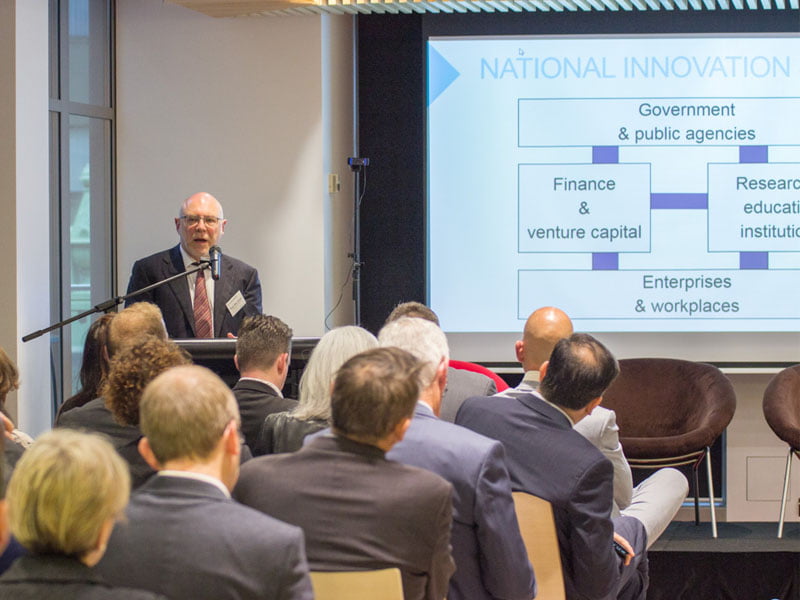Whatever the government has planned for its Innovation Statement – expected before Christmas – it will almost certainly contain some long-term thinking around research funding and how it is structured.
This will be a keenly-contested political conversation between now and the next election. With the Commonwealth funding more than $9 billion in research funding annually, the nation’s highly successful research sector is not without deeply entrenched interests.
Funding ideology for research splits to the two main parties, even if the objectives are the same – support for the research sector and improved financial performance for the research results.

Speaking at InnovationAus.com’s Open Opportunity Forum this morning, UTS Business School Dean Prof Roy Green posed an uncomfortable question about funding: “If we have a funding envelope of $9.7 billion and we throw it in the air, where would we like it to land?”
And that is effectively what the various reviews of the Australian innovation system – and the government’s Innovation Statement – aim to decide. Because right now, vast tracts of public research funding either undirected, or directed according an inconsistent set of priorities and methods.
Right now, the spending of that $9.7 billion is not organised in a coherent way. Research funding responsibilities are spread across 13 different portfolios, with little consistency across government where money is directed.
Research funding represents more than 150 line items in the Commonwealth budget. The funding picture is completed by the disparate Federal-State priorities.
There have been 60 reviews of the innovation system in Australia – or signature parts therein – over the past 15 years. Inexplicably “only four or five of them refer to each other,” Prof Green says.
And then there is the R&D tax concession, which makes up about 30 per cent of the government’s $9.7 billion research bill. This is an entirely undirected sum – and will almost certainly be the subject of some movement in the government’s impending Innovation Statement.
There is certainly no wrong about a portion of government’s R&D spending being undirected. Tax concessions give the system flexibility. It doesn’t force government or its proxies to ‘pick winners’.
But proportionally, 30 per cent is a very big number, and Prof Green wonders out loud whether “we need to make an objective assessment of how and where that money gets spent.”
“The amount we spend on the Entrepreneurs Program is a pin-prick compared to the R&D tax arrangements,” he said.
Prof Green wrote the Senate Economics committee’s recently published interim report for its inquiry into the National Innovation System (the final report is expected at the end of November) and has been a consistent voice for the drive to improve linkages between the various parts of the system.
This is a large and complex policy issue for government. But it is heartening to see long-termism creeping into the discussion (including in relation to the startup end of the market).
Prof Green says a national body for “coordination and foresight” is necessary. Its membership can be made up across institutional research, academia, government and business – but its view must be long term.
“Because we can’t do everything, we need to understand what we do well,” he said And currently we have a science construct that doesn’t connect with the rest of the eco-system.
Assistant Science Minister Karen Andrews says a 10-year strategic window seems about right in relation to science research priorities. This decade-long horizon can be modified along the way and circumstances and technology dictates – but a clear set of priorities looking 10 years into the future makes sense.
This finding horizon will look much further than Australian institutions. Mrs Andrews is clearly interested in driving better and deeper research linkages with foreign institutions, including funding of projects outside of Australia.
That’s interesting – especially given Mrs Andrews wants a much more targeted focus on Asia, on partners who share our time zone to the north. Creating these partnerships in Asia was not just about money: “We need to work out what our strengths are and what we can offer our partners – especially our Asia neighbours.”
Innovative research and technology in CleanTech, Health & Ageing, and Agritech were all application areas where Australia has existing strength, and there is demand from potential research partners.
Finally, Mrs Andrews has continued her mantra about the innovation picture being much bigger than just looking at startups – a sentiment also talked about by Assistant Innovation Minister Wyatt Roy.
“Science needs business. Business needs science. And Australians need both,” Mrs Andrews said.
Do you know more? Contact James Riley via Email.

